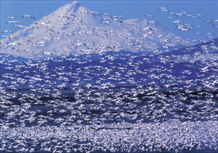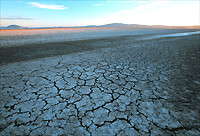|
|
Drought, Fight for Limited Water, Imperil Klamath Basin, Refuges
By Mari Margil
Oregon Chapter Conservation Coordinator
 Straddling the border of northern California and southern Oregon is the largest interior freshwater wetlands system west of the Mississippi - the Klamath Basin, known by some as the "Everglades of the West." Straddling the border of northern California and southern Oregon is the largest interior freshwater wetlands system west of the Mississippi - the Klamath Basin, known by some as the "Everglades of the West."
A critical resting and feeding ground for migratory birds and waterfowl on the Pacific Flyway, it is also the winter home for as many as 1,100 bald eagles, a species listed as threatened under the federal Endangered Species Act.
 But in the past year, severe drought conditions have hit the basin, and the longstanding conflict over precious water resources has, for the first time, garnered local and national media attention. In a landscape much altered by human hands, the Klamath Basin, once rich in waterfowl and other wildlife, is now host to imperiled species, including salmonids and eagles. Unfortunately, according to local Sierra Club organizers, much of what has been reported in the media has mischaracterized the issue as a fish-versus-farmers fight. But in the past year, severe drought conditions have hit the basin, and the longstanding conflict over precious water resources has, for the first time, garnered local and national media attention. In a landscape much altered by human hands, the Klamath Basin, once rich in waterfowl and other wildlife, is now host to imperiled species, including salmonids and eagles. Unfortunately, according to local Sierra Club organizers, much of what has been reported in the media has mischaracterized the issue as a fish-versus-farmers fight.
The basin, in turn, has become a lightning rod for anti-Endangered Species Act and property-rights advocates. There are signs posted with "ESA" in a circle with a line through it. There have been rallies and even a bucket brigade to symbolically carry water to farmers.
In April, the federal government halted irrigation flows from the irrigation headgates, but several times since then farmers have breached the headgates - and law enforcement officials have refused to take action.
"It has been difficult, in the middle of all this, to get the real story out there," said Tom Dimitre, chair of the Oregon Chapter's Rogue Group, which monitors the issue.
The real story is that a century ago the Bureau of Reclamation began manipulating an area once abundant with wildlife. Dams, diversions and dikes allowed farmers to grow potatoes, horseradish, sugar beets and other crops. As a result, 75 percent of the wetlands have been filled, and the U.S. Fish and Wildlife Service reports that 113 of 410 wildlife species are "of concern" or "at risk."
The Bureau of Reclamation still controls the water that goes through the refuges and into - and out of - the Klamath River throughout its jurisdiction in the basin.
In April, Fish and Wildlife and the National Marine Fisheries Service issued Biological Opinions - referred to as BiOps - requiring minimum water levels for federally listed mullet and coho salmon in the Klamath Basin. Mullet inhabit the refuges, and salmon are found in the river. Species listed under the Endangered Species Act have first priority for water in the basin, followed by tribes, irrigators and then national wildlife refuges.
In order to keep the minimum water levels in the Upper Klamath Lake and the Klamath River for the fish - levels just to keep them alive, not to move them toward recovery - other water users, including the refuges and some farmers, were unable to receive water.
Yet limited water in the basin is nothing new. The Klamath Basin's six national wildlife refuges, last in line for water, for years have received insufficient water, and the water quality is deteriorating.
"A century of over-appropriation of water, destruction of wetlands which store water, damming and diking of rivers, degraded water quality, and constant human alteration of the environment in the basin are responsible for the current situation - not the Endangered Species Act," said Dimitre.
And this isn't the first year farmers have seen economic woes. Many were already struggling because of the trade agreements with Mexico, which have significantly cut the market for the crops grown in the basin, Dimitre said. "Government subsidies have kept many of them going," he said.
The Oregon Chapter has worked for years in the area, focusing on eliminating commercial agriculture and toxic pesticide use from the refuges. The Sierra Club has designated the basin's refuges as one of 33 special places to be protected as part of its campaign commemmorating the bicentennial of the Lewis and Clark expedition.
"Protecting the area will entail a long-term solution that addresses the needs of endangered species, wildlife, fishing communities, tribes and farmers," said Dimitre.
 |
Tell your senators and representative that attacks on the Endangered Species Act only serve to distract decision-makers from crafting a long-term Klamath Basin plan that supports a sustainable level of farming, economic transition for farmers and downstream fishing communites. The plan should aid the recovery of threatened salmon and other imperiled species, restore habitat for waterfowl and wildlife and re-establish wetlands for increased water storage and improved water quality. Addressing the concerns and needs of Klamath Native American tribes will be a key component.
For more information, check out the Oregon Chapter's Website. Or contact John Anderson at jranderson@coinet.com, or Mari Margil at mari.margil@sierraclub.org. |
Photo (top) courtesy U.S. Fish and Wildlife Service, (bottom) courtesy Ellen Morris Bishop
Up to Top
|